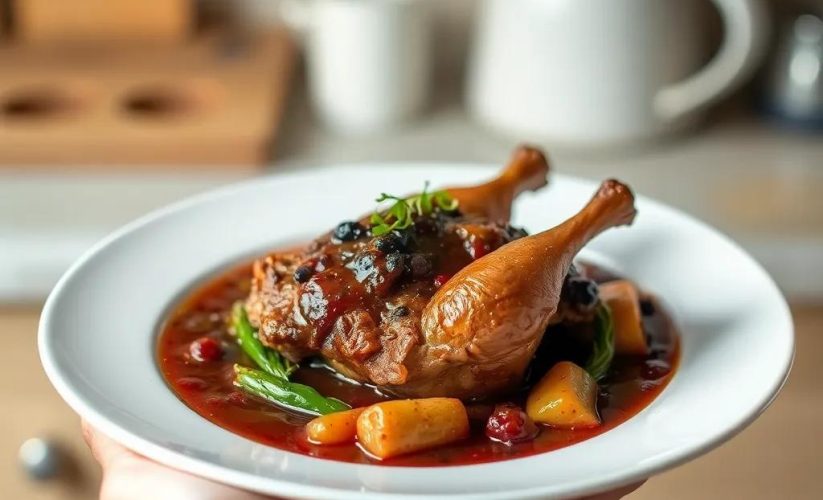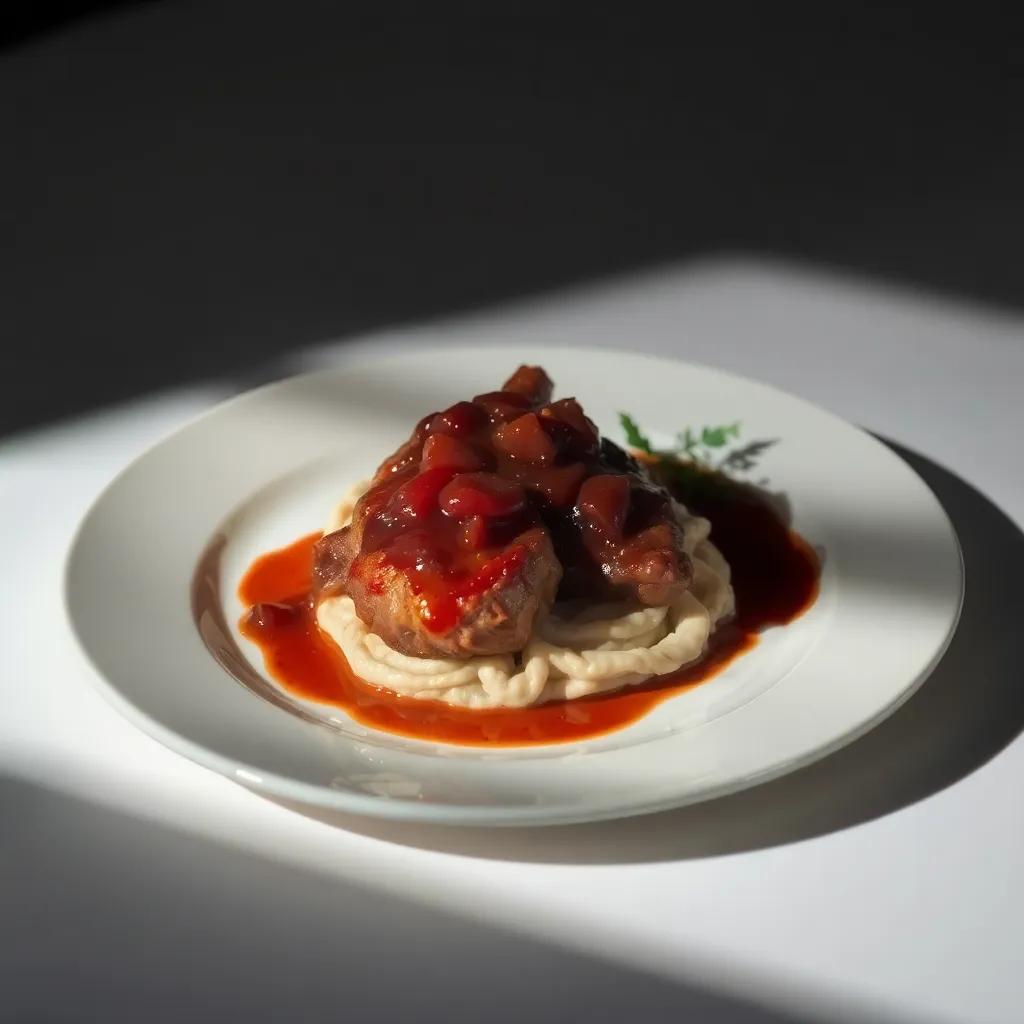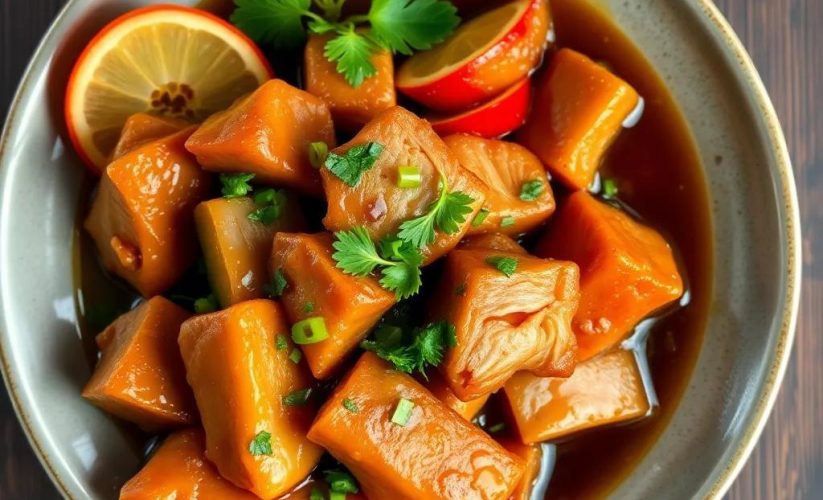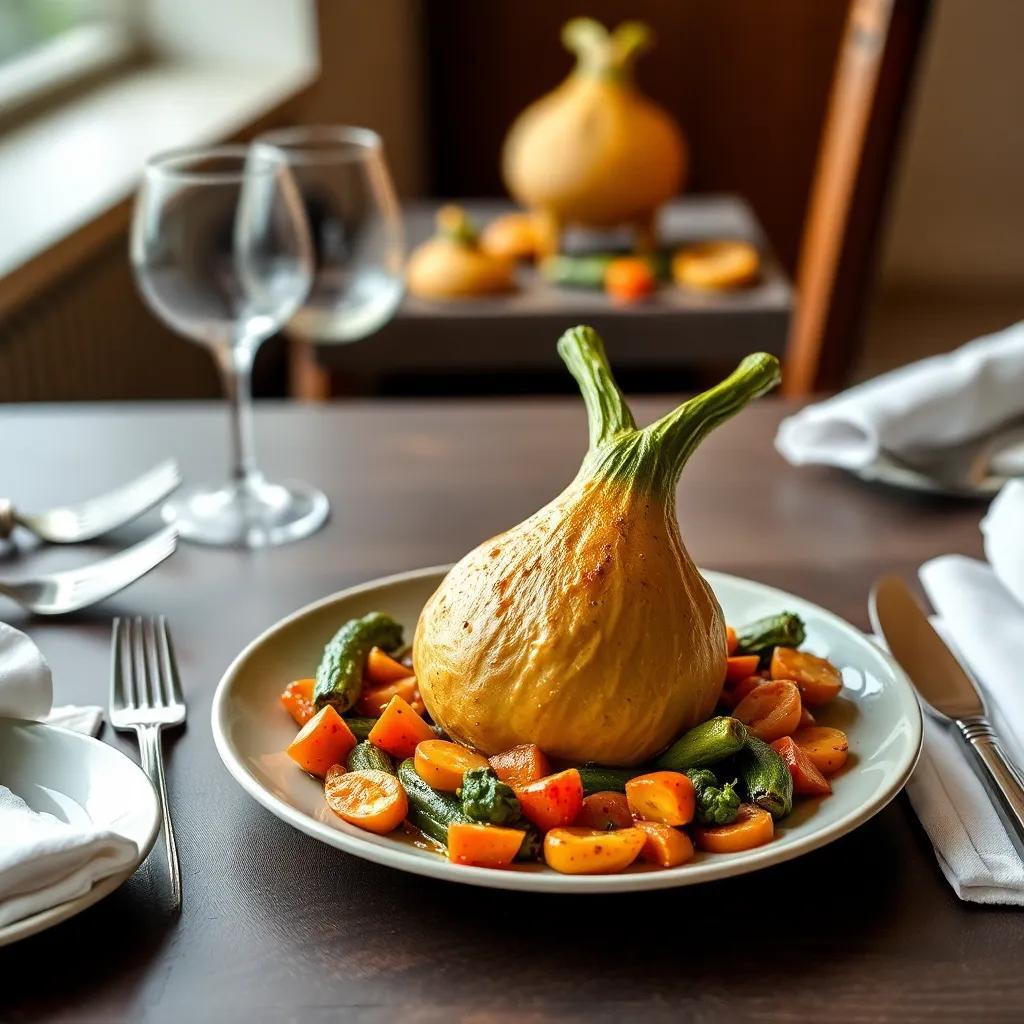Master Classic Coq au Vin: Easy, Rich French Chicken Recipe

Master Classic Coq au Vin: Easy, Rich French Chicken Recipe
🌍 Cuisine: French
⚙️ Difficulty: Medium
Ingredients
Nutrition Facts
550
Instructions
- Pat the chicken pieces dry with paper towels and season generously with salt and pepper.
- In a large heavy-bottomed pot or Dutch oven, cook the diced bacon over medium heat until crisp. Remove with a slotted spoon and set aside, leaving the fat in the pot.
- Add olive oil to the bacon fat if needed. Brown the chicken pieces in batches over medium-high heat until golden all over, about 5 minutes per side. Remove chicken and set aside.
- Add the sliced onion and minced garlic to the pot and sauté until softened, about 5 minutes.
- Sprinkle the flour over the onions and stir well to coat, cooking for 1-2 minutes to remove the raw taste.
- Slowly pour in the red wine while stirring to deglaze the pot. Add chicken broth, tomato paste, bay leaf, and thyme sprigs. Stir to combine.
- Return the chicken pieces and cooked bacon to the pot. Bring to a gentle simmer, cover, and cook for 45 minutes to 1 hour until the chicken is tender and cooked through.
- While the chicken cooks, melt some butter in a skillet and sauté the pearl onions until golden, about 8 minutes. Add mushrooms and cook until tender and lightly browned.
- When the chicken is cooked, remove pieces to a plate and discard bay leaf and thyme sprigs.
- Stir the sautéed mushrooms and pearl onions into the sauce. Simmer uncovered for 10 more minutes to thicken and meld flavors. Adjust seasoning with salt and pepper.
- Return the chicken to the pot to warm through.
- Garnish with freshly chopped parsley before serving.
- Serve hot with crusty bread, buttered noodles, or mashed potatoes to soak up the rich sauce.
Serving Suggestions
- Serve with creamy mashed potatoes to soak up the flavorful sauce.
- Accompany with buttered egg noodles or wide pasta ribbons.
- Pair with crusty French baguette or rustic country bread for dipping.
- Add a simple green salad with a light vinaigrette to balance the richness.
- Enjoy alongside steamed green beans or sautéed asparagus.
- Complement with a glass of the same Burgundy or Pinot Noir used in cooking.
- Top with fresh parsley or chives for a fresh herbal note.
Table of Contents

Intro
Coq au Vin is the kind of dish that invites you to slow down, unwind, and savor each bite—a timeless French classic that transforms humble chicken into a gourmet experience. What makes this recipe truly special is how effortlessly it balances rich, layered flavors with a straightforward cooking process. Whether you’re impressing guests at a dinner party, cozying up for a weekend family meal, or simply craving comfort food with a touch of elegance, this version of Coq au Vin fits the bill perfectly.
The magic lies in the harmony of deep, red wine-infused sauce, tender chicken, and the savory aroma that fills your kitchen as it simmers gently. There’s something wonderfully satisfying about creating a dish that tastes like it took hours in a professional kitchen, yet can be made with accessible ingredients and achievable steps. This recipe invites cooks of all levels to explore French cooking traditions without feeling overwhelmed.
Perfect for cooler evenings or special occasions, Coq au Vin pairs beautifully with a variety of sides—from buttery mashed potatoes to crusty bread—making every serving a vivid celebration of textures and tastes. It’s a dish that encourages sharing, lingering at the table, and enjoying the warmth of good company alongside good food.
Ingredient Notes
A few key ingredients in this Coq au Vin recipe truly define its authentic depth and character. Understanding their role and sourcing tips can elevate your cooking experience and ensure the best flavor in every bite.
Dry Red Wine (Burgundy Preferred):
The wine is the soul of Coq au Vin, imparting rich fruitiness and subtle tannins that mellow into the sauce during slow simmering. While Burgundy (Pinot Noir) is traditional due to its balanced acidity and delicate berry notes, any dry red wine with medium body—like a Beaujolais or Côtes du Rhône—can work well. Avoid inexpensive “cooking wines” loaded with salt or preservatives; instead, choose a bottle you’d enjoy drinking. The alcohol cooks off, leaving behind a luxurious complexity that’s essential to this dish.
Bacon or Pancetta:
This ingredient brings an irresistible smoky, savory foundation to the stew. The rendered fat adds depth and a silky texture while the crisp bits contribute bursts of flavor. Pancetta offers a milder, slightly sweet cured pork option, while smoked bacon introduces a more pronounced smokiness. If neither is available, a good-quality smoked ham or even guanciale can be substituted, but try to avoid lean pork cuts, as fat plays a crucial role here.
Pearl Onions:
These small, sweet onions provide subtle sweetness and tender pops of texture that contrast beautifully with the hearty chicken and mushrooms. Though labor-intensive to peel, pearl onions greatly enhance the dish’s authenticity. If fresh pearl onions aren’t in season or convenient, frozen peeled pearl onions are a fine alternative. You can also substitute small white or yellow onions cut into quarters, but the distinctive bite and sweetness will be less pronounced.
Cremini or White Mushrooms:
Mushrooms add an earthy, meaty dimension to balance the wine’s acidity and the richness of the sauce. Cremini mushrooms have a deeper flavor and firmer texture compared to milder white button mushrooms, making them a preferred choice. When selecting mushrooms, choose firm, dry specimens without dark spots or sliminess. If fresh mushrooms are unavailable, high-quality canned or jarred mushrooms can be used, though fresh yields the best texture and flavor.
By paying attention to these core ingredients and selecting fresh, quality versions, you unlock the authentic essence of this classic French dish — turning simple elements into a masterpiece of flavor and comfort.
Tips & Variations
To bring out the very best in your Coq au Vin, consider these practical tips and creative twists that allow you to personalize the dish while maintaining its classic charm.
Pro-Level Tips:
- Patience is Key: Browning the chicken thoroughly in batches not only adds beautiful color but also develops deep flavor through the Maillard reaction. Resist overcrowding the pan to avoid steaming the meat.
- Deglaze with Confidence: When adding wine to the pot, scrape up those browned bits stuck to the bottom—they’re flavor gold. This step enriches the sauce with complex, caramelized notes.
- Simmer Low and Slow: Cooking the stew at a gentle simmer rather than a rolling boil keeps the chicken tender and prevents the sauce from becoming cloudy or harsh in taste.
- Mushroom and Onion Timing: Sauté pearl onions and mushrooms separately before adding back to the stew. This technique preserves their texture and ensures they don’t turn mushy during the long braise.
- Strain or No Strain: For an ultra-smooth sauce, strain the braising liquid before adding the sautéed vegetables back. But keeping it rustic with everything combined is equally delicious and far less fuss.
Customization & Variations:
- Wine Alternatives: While Burgundy or Pinot Noir is traditional, you can experiment with a good-quality Merlot, Zinfandel, or even a robust Syrah. For whites, a dry white wine or even vermouth can create a lighter coq au vin blanc variation.
- Protein Swaps: If chicken isn’t your preference, turkey legs or thighs can be used. Duck is also a luxurious substitution, amplifying the richness of the dish.
- Vegetarian/Vegan Version: Skip the chicken and bacon entirely and substitute with hearty mushrooms (like portobello or king oyster), smoked tofu, or seitan. Use vegetable broth and choose a rich, fruity vegan red wine. Nutritional yeast or umami-rich miso can add depth in place of meat.
- Gluten-Free Adaptation: Swap the all-purpose flour for a gluten-free flour blend or cornstarch slurry to thicken the sauce. Just add gradually at the flour step and stir well to avoid lumps.
- Herb Variations: While classic thyme and bay leaf anchor the dish, rosemary, tarragon, or a bouquet garni with parsley stems and oregano can add interesting herbal nuances.
- Adding Vegetables: Toss in diced carrots, celery, or even small potatoes early on for a heartier one-pot meal. Roasted root vegetables can also be served alongside for extra texture and sweetness.
- Smoky Touch: For a smoky twist, consider adding a splash of liquid smoke or using smoked paprika in the seasoning. This works wonderfully if you prefer to forgo bacon or pancetta.
Flavor Enhancements:
- Finish with Butter: Stirring in a knob of cold butter at the end of cooking gives the sauce a glossy, velvety finish and rounds out acidity.
- Acidity Balance: If the sauce feels too sharp from the wine, a teaspoon of honey or a splash of balsamic vinegar can help balance flavors without overpowering.
- Mushroom Varieties: Mix cremini with wild mushrooms like chanterelles or porcini for a more earthy, forest-inspired note.
Through these tips and variations, you can tailor your Coq au Vin to suit personal tastes, dietary needs, and ingredient availability—all while honoring the essence of this timeless French classic.
Leftovers & Storage
Leftovers of Coq au Vin are a true delight, often tasting even better the next day as the flavors have more time to meld and deepen. To keep your leftover chicken stew fresh and delicious, proper storage is key.
After your meal, allow the Coq au Vin to cool to room temperature (but no longer than two hours to avoid food safety risks). Transfer the stew into airtight containers—glass or BPA-free plastic containers with tight-fitting lids work best to preserve flavor and prevent odors from mingling in your fridge or freezer. Divide the portions if you plan to reheat only small servings at a time.
Stored properly in the refrigerator, Coq au Vin will stay fresh for 3 to 4 days. This makes it ideal for meal prep, so you can enjoy this comforting French dish again without any extra cooking effort. Always reheat gently on the stovetop over medium heat until warmed through, stirring occasionally to prevent the sauce from scorching. You can also microwave individual portions covered loosely, stirring halfway through.
For longer storage, Coq au Vin freezes wonderfully. After cooling, pack the stew in freezer-safe containers or heavy-duty freezer bags, leaving some headspace for expansion. Label with the date, and use within 3 months for the best taste and texture. When ready to enjoy, thaw overnight in the refrigerator and reheat slowly on the stove, adding a splash of chicken broth or water if the sauce has thickened too much.
If you plan to pack Coq au Vin for lunches or picnics, store it in an insulated container to keep it warm and safe to eat. Just reheat fully beforehand and keep chilled until ready to eat if serving cold. The richness and tender chicken make it a satisfying, hearty option for on-the-go meals.
With these storage tips, your Master Classic Coq au Vin remains a star performer well beyond the dinner table—ready to comfort and impress whenever the craving strikes again.
Behind the Recipe
Coq au Vin is much more than a delicious dish; it’s a culinary story steeped in tradition and history. Originating from the rustic heartlands of Burgundy, France, this classic stew was born from necessity—a way to tenderize tougher rooster meat by braising it slowly in wine, creating a dish that is both humble and luxurious at once. The name itself, meaning “rooster in wine,” captures the essence of how French peasants transformed everyday ingredients into a meal worthy of celebration.
Over the centuries, Coq au Vin evolved from farmhouse kitchens into haute cuisine, embraced by chefs and home cooks alike for its comforting richness and elegant depth. This particular recipe honors that heritage, focusing on accessibility without sacrificing authenticity. Using a whole chicken instead of a traditional older rooster reflects modern practicality, making the dish easy enough for weeknight dinners yet special enough for Sunday gatherings or dinner parties.
Personally, this recipe evokes memories of cozy evenings spent with family, where the kitchen fills with the seductive aroma of sizzling bacon, caramelized onions, and simmering wine. It’s a dish that invites patience and rewards with layers of flavor building slowly, much like how meaningful connections develop over time. Each forkful is a reminder of French cooking’s magic—the way simple ingredients become extraordinary through care and tradition.
Ultimately, this classic Coq au Vin bridges past and present, bringing a taste of French countryside charm into your home with every savory bite. It’s a timeless recipe that invites you to slow down, savor, and create your own stories around the table.
FAQ
Can I make Coq au Vin with a different type of wine or alcohol?
Is there an easy way to adapt this recipe for a dairy-free or gluten-free diet?
How far ahead can I prepare Coq au Vin, and how should I store leftovers?
Can I swap the chicken for another protein or a vegetarian alternative?
What are some good side dishes to serve with Coq au Vin?
Is it necessary to marinate the chicken in wine beforehand?
Wrapping It Up
There’s something truly special about mastering a classic like Coq au Vin—its rich, comforting flavors and timeless French charm make every bite a small celebration. Whether you’re cooking for a cozy night in or impressing guests, this easy-to-follow recipe brings a touch of rustic elegance to your kitchen without any fuss.
Give it a try and savor the delicious results! I’d love to hear how your version turns out—feel free to leave a comment, share your rating, or even tell us about your own unique twist. Happy cooking!












